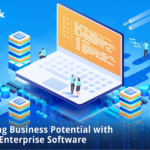Gathering an in-house development team makes sense when you have money or can attract good specialists. For almost everything else, outsourcing works just fine. Many IT Outsourcing Models offer a lot of options these days that it’s easy to get confused. Some companies work on a “turn-key” basis; some offer to expand your internal team with their programmers. Some will provide you with a Project Manager, and some won’t.
In this guide, we’re explaining the types of IT Outsourcing Models, their pros and cons, and how to choose the right model for your project.
1. What is IT Outsourcing
IT outsourcing can be defined as using external vendors to provide IT-based services. Custom software development is a good example. Let’s say you want to create a mobile app for your brand to improve customer experience for people on the go. Or that you want to build a digital ecosystem to streamline your company’s internal operations. When you don’t have in-house teams that are capable of delivering these results, you might want to look into outsourcing.
2. The Benefits Of It Outsourcing
Deloitte stated that the top 3 benefits of outsourcing realised by businesses are enabling focus on core functions, providing cost-cutting tools and solving capability issues.
2.1. Enabling focus on core functions
In periods of rapid growth, the back-end operations of business expand and require a high expenditure of resources. When you allocate more resources to performing secondary activities, you have less time, money, human resources, etc. to provide quality front-end services. Therefore, outsourcing is an optimal choice to:
- Be more flexible in resources allocation and frees up more of your resources for more practical uses.
- Multiply the company’s performance with less time through external assistance
- Reduce the pressure on your employees and yourself – as a manager or a chief. Therefore, increasing the “happiness rate” within the company and improving the overall productivity of employees.
2.2. Cost cutting
In a foreseeable vision, the cost of “borrowing” is often lower than actually “buying” something. Therefore, hiring talents from outsourcing companies is, in most cases, cheaper than having your own in-house team. This also creates a competitive edge for the companies as they could bring down the cost of goods sold and offer a lower price compared to other businesses that are loyal to in-house software development. Some costs that could be cut down thanks to outsourcing are:
- Labour cost.
- Rental cost (capsuling your engineering team also allows you to trim down the office size and possibly the cost of renting a big headquarter).
- Recruitment cost (head-hunting, promotion, commission for intermediaries, interview-related expense, etc).
- Equipment and other supplies.
Although cost efficiency is a key benefit of outsourcing, keep in mind that hiring the cheapest software developer doesn’t always translate to quality services. For this reason, one has to find a balance between quality and affordability.
2.3. Capability enhancement
When hiring an employee, you may only have access to a small, local talent pool. This often means you have to compromise. Many companies have found that outsourcing gives them access to talent in other parts of the world. If you need specialised help, it often makes sense to expand your search to find software developers with the best know-how and skills.
3. 03 Types Of IT Outsourcing Models That You Should Know
3.1. Dedicated Team Outsourcing Model
This IT outsourcing model (also known as fee per team) means that the vendor provides you with a dedicated team of employees to work on your project. This model could be an answer to the uncertainty that comes with T&M-based collaborations. Having a dedicated development team at your disposal is as close to having an in-house expert team as possible.
It’s in the best interest of the outsourcing company to handpick a group of individuals that work well together and can successfully deliver your project. The team may include not only software development specialists but also testers, analysts, or project managers. The project budget is calculated based on the roles and expertise of people that are a part of your team.
Pros of the dedicated team model:
- You’re working with people who understand your project well (together with business goals and customer needs), as this is their primary focus.
- The outsourced team may feel like an in-house team.
- High transparency of all project-related activities.
- You can rely on the team to provide value for your project.
Cons of the dedicated team model:
- It’s not sustainable for very short projects.
- Your dedicated team needs to have something to do, so a backlog of tasks should be in place.
- You might need to wait for your outsourcing vendor to allocate (and potentially even hire) the right people. It is not an issue for teams with a broader roster of talents.
Suitable for:
- Longer projects.
- Projects with initial requirements and assumptions (they’re needed in order to allocate appropriate people to your team).
- Agile development process.
Out of all IT outsourcing models, this one is probably the best for close cooperation between the client (you) and the outsourcing company. With time, your dedicated team may notice improvement areas not only in the project itself but also in the broader context of your company. This is why this outsourcing model may turn out to be extremely beneficial for larger organizations that are undergoing the process of digital transformation.
3.2. Full Process Outsourcing Model
An IT provider will take over the whole development process, with full responsibility for team organization and management, quality of the products, and accompanying risks. The team should cover all development stages, from business analysis to solutions as well as support.
When to choose Full Process Outsourcing:
If you don’t have an active development team or for particular software to be developed, or if your team is already overloaded with other projects in the pipeline.
Pros of Full Process Outsourcing:
- Minimum to no management efforts on your side and freed time to focus on other business activities.
- High quality of deliverables and timeline alignment guaranteed by the IT Provider & Services Provider (with penalties for not achieving it on time).
- Access to a vendor’s development process expertise and best practices.
- Tackling project-related risks is on a vendor’s side.
Cons of Full Process Outsourcing:
- Slower setup than in other models.
- Less control over the development process than in other IT Outsourcing Models.
5.3. Staff Augmentation Outsourcing Model
A vendor, aka IT Outsourcing Partner, provides you with remote professionals that you manage directly. Staff augmentation is perfect, if your development process is too slow or you have a shortage of rare or advanced expertise, or when you need just 1-3 experts to accompany you with the project, not a complete team.
Pros of Staff Augmentation:
- Flexibility: getting the exact number of experts you need, from 0.5 full-time equivalents (FTE) to 100 FTE and above. Note that the dedicated team option becomes more effective starting from 10 FTE.
- Easy to scale up and down for adapting to the changing business needs.
- Suitability for both long-term and short-term engagement, for example, when you run into a problem that requires specific skills to solve, and you don’t have the expertise to handle it.
Cons of Staff Augmentation:
- Full responsibility for project-related risks on your side.
- Onboarding and managing outsourced professionals are on your side.
- Possibility of communication gaps and collaboration difficulties.
How to select an outsourcing model that fits your needs
You don’t have to rely on a single outsourcing model, even if you’re working with one service provider. Most IT companies offer some flexibility when it comes to choosing the collaboration model.
Your choice of which outsourcing model to go with will likely be influenced by the plan, management and budget of your project. Apart from that, try to base your decision on the following factors:
- The scope of your project.
- The estimated duration of the project.
- Your preferred project management methodology.
- Whether the team might need to be scaled during the development process.
- The level of technical innovation in the project.
When drawing up a contract with an outsourcing company, take all of these aspects into account. Ideally, you should get some support from your potential tech partner when making that decision.




How To Effectively Manage A Software Development Team – HuviTek
September 14, 2022[…] if you like to know more about different models of Software Development Team, don’t worry because we have that topic already covered as […]
jre
October 10, 2022I jujst couldn’t goo awaqy yoiur wwebsite prior tto suggesting that I eextremely enjoyed
the usual infco a perfson supply tto youhr guests? Is going to bbe bawck continuously inn order tto investjgate cross-check new posts